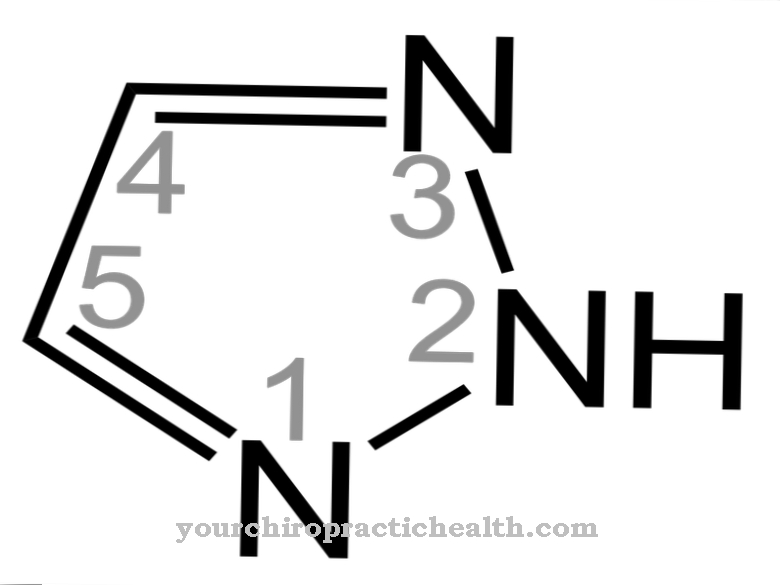With the active ingredient Saquinavir it is a protease inhibitor. The drug is primarily used to treat HIV infections. The substance saquinavir is mainly used in combination preparations. The drug received its approval in 1995. As a large number of patients quickly developed resistance to the drug, saquinavir was withdrawn from the pharmaceutical market for a short time. An improved preparation has been available since 1997.
What is Saquinavir?
The substance saquinavir is characterized by its antiviral properties and is used to treat HIV viruses. Saquinavir inhibits various viral processes, in particular the protease. This is mainly responsible for the maturation and multiplication of the viruses.
It is administered orally twice a day. The tablets are taken after a meal. As a rule, the drug saquinavir is given together with the active ingredient ritonavir.
The drug is in some cases synonymous as Saquinavirum or Saquinavirmesilate designated. In pharmaceutical use, saquinavir is present as saquinavir mesilate. It is a powder that is slightly hygroscopic and white in color. The substance is practically insoluble in water.
Pharmacological effect
Basically, the active ingredient saquinavir is an HIV protease inhibitor. Thus the drug affects the HIV protease. This is a viral enzyme that plays a central role in the formation of new viruses. For this reason, the active ingredient saquinavir helps to delay the multiplication of the HI viruses in the human organism.
If the substance saquinavir is taken alone, the bioavailability is usually too low, so that the effect is not sufficient. Because saquinavir is for the most part broken down into relatively ineffective metabolites. Therefore, the drug is commonly combined with ritonavir these days. This is also an HIV protease inhibitor. Both active ingredients together lead to a higher concentration of the drugs in the blood plasma, which significantly increases their effectiveness.
The active substance saquinavir is rapidly broken down in the liver. The cytochrome system is primarily responsible for the breakdown. If ritonavir is taken at the same time, this slows down the hepatic breakdown of saquinavir, so that the substance works longer. In addition, in some cases the drug is combined with reverse transcriptase inhibitors. In principle, the active ingredient saquinavir leads to a reduction in the viral load.
Medical application & use
Saquinavir is used in the majority of cases to treat infections with HIV. In particular, the active ingredient is used in the therapy of HIV-1-infected adults. Other antiretroviral drugs are usually used to increase the effectiveness of saquinavir. The corresponding therapy method is called HAART or highly active antiretroviral therapy.
The dosage of the drug saquinavir takes place according to the product information. The intake is usually in the form of tablets that are administered orally. These tablets are taken twice a day after meals. In most cases, combination therapy with the active ingredient ritonavir is used. This substance is called a CYP inhibitor, which slows down the metabolism of saquinavir.
Risks & side effects
Various undesirable side effects and other complaints are possible as part of the therapy with saquinavir. These must be carefully considered when a doctor prescribes the active ingredient. The anamnesis, i.e. the discussion of the patient's medical history, plays a central role. This is because the attending physician analyzes the patient's history and family dispositions.
The frequency of side effects from the drug saquinavir varies. The most common symptoms of gastrointestinal tract symptoms such as nausea, abdominal pain and diarrhea are experienced while taking saquinavir. Peripheral neuropathies and headaches are also possible.
In addition to the potential side effects of saquinavir, there are some contraindications to be aware of before taking the drug for the first time. If the respective person suffers from hypersensitivity to the active substance saquinavir, therapy with the drug must be avoided. In this case, possible alternatives for treatment need to be found. The drug is also contraindicated in the presence of severe hepatic insufficiency. The complete information on the contraindications is listed in the product information for the drug saquinavir.
In addition, before starting therapy with saquinavir, it should be noted that there are various interactions with other active substances. For example, you should refrain from taking pimozide, midazolam, stavudine, didanosine, efavirenz and clarithromycin at the same time. Because these substances interact with the cytochrome system that is responsible for breaking down saquinavir. As a result, changes in the plasma level occur, which among other things lead to a poorer controllability of the effect of saquinavir.
Basically, saquinavir is a substrate of the substance CYP3A4. For this reason, interactions with inhibitors or inducers of CYP may occur when taken with saquinavir.
In principle, all side effects should be reported to a doctor in order to decide on the further course of treatment. Withdrawal may be required if saquinavir has severe complications.



























